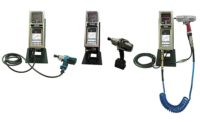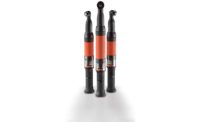Current Trends in Electric Tools
For years, DC electric tools have given assemblers unmatched control over the process of tightening threaded fasteners. However, the high cost of the tools often meant that assemblers reserved them only for joints that were critical to the safety or function of the product. Today, a host of technological advances are allowing assemblers to use these tools in more applications than ever before.
"In 1999, DC electric tools were primarily used on safety-critical joints in automobiles," says Steve Chapman, product manager for assembly tools at Cooper Power Tools (Lexington, SC). "Since prices have come down, other industries have been able to justify the additional cost of these tools."
A DC electric tool is equipped with a transducer to measure torque and an encoder or resolver to measure angle. Powered by a servomotor and governed by a microprocessor-based controller, the tool can run down a fastener to a specific torque or angle. Alternatively, the tool can tighten the fastener to a specific torque, while monitoring angle. It can run down the fastener to a specific angle, while monitoring torque. Or, the tool can tighten the fastener to both a specific torque and a specific angle. Moreover, a DC electric tool does all this with a high degree of accuracy, typically less the 3 percent of the desired value.
Measuring angle gives assemblers another check on the quality of the fastening process. On every joint, a threaded fastener will rotate a certain number of degrees after reaching snugness, or threshold torque. For example, if a washer is missing from an assembly, or if there are two washers instead of one, the fastener will not turn as much as expected. A DC electric tool can detect the problem and notify the operator of the fault.
"If the fastener turns too much, that could it mean has yielded or been stripped," adds Steve Shepard, technical service manager at AIMCO (Portland, OR). "If it turns too little, that could mean the fastener has been cross-threaded and it didn't go in all the way."
The speed of the tool can also be set. For example, assemblers can program the tool to start slowly, so the socket has a chance to mesh with the nut or bolt head. To shorten cycle time, the tool can be set for maximum speed during the initial phase of the run-down. Then, near the end of the run-down, the tool can slow down. This helps ensure a repeatable process.
Torque, angle and speed control can be important when installing self-tapping screws, says Chapman. "The prevailing torque is often higher than the seating torque," he explains. "An air tool might shut off prematurely, but an electric tool can be programmed to ignore the prevailing torque until a certain angle."
Electric tools allow assemblers to program fastening routines. For example, the tool can be set to run down a fastener, back it off slightly, then run it down again. Such a routine can be useful for fastening joints that include gaskets.
Many of the advances in electric tools during the past 5 years have been in networking. In the past, engineers would upload fastening programs to the controller and download the accumulated assembly data. Only a limited amount of programs and data could be saved. Today, tool controllers can be connected directly to shop-floor networks through Ethernet, DeviceNet or other bus. Data on each and every fastener can be recorded and stored, and engineers can tweak the fastening process from their desks-or the beach-via laptop and a wireless Internet connection.
Most controllers also have I/O, which allows them to perform many of the functions of a PLC, transmitting signals back and forth from peripheral equipment on the line, such as code readers, conveyor gates, signal lights and socket trays. This can help engineers error-proof the fastening process, Shepard says.
Thus, when a pallet arrives at an assembly station, a bar code or radio frequency identification tag can tell the controller and the assembler what fasteners to install, how many to install, and even where to install them. Torque, angle and speed settings for each fastener are communicated automatically to the tool, without the need for operator intervention. If four bolts must be installed at the station, the controller can count the number of fastening operations performed by the operator. If not enough run-downs are completed, or if some of the run-downs do not meet quality standards, the controller will trigger an alarm and will not release the pallet to the next assembly station. In addition, the controller can "marry" the data from each fastening operation to the code or tag for that individual product, while simultaneously sending the data off to be analyzed in aggregate.
Engineers can use this data to spot potential problems before bad joints are assembled, says Chapman. In addition, engineers may be able to tweak their initial tool settings to improve the overall efficiency of the fastening operation.
Entry-Level Electrics
Of course, with great accuracy and control also comes a large price tag, and electric tools have always been more expensive than their pneumatic counterparts. Today, that price gap is narrowing, thanks to improvements in the size, cost and power of microelectronics.
One beneficiary of these advances is the new Plug and Tighten line of DC electric tools from Chicago Pneumatic (Rock Hill, SC). Microelectronics located within the tool itself obviate the need for an external controller. The tool plugs directly into a standard 110-volt or 230-volt outlet. Run-down programming is done through a keypad on the tool or through a Pocket PC and a wireless Bluetooth connection.
"You can program the tool in 60 seconds," says Andrew Bardsley, business line manager for assembly at Chicago Pneumatic. "You enter a torque value, do three run-downs, and the tool learns the joint and automatically sets the parameters for angle, high speed and shift-down speed."
Through the Pocket PC, engineers can set their own angle and speed values. They can also program the tool to require a two-handed start, to ensure safety when the tool is being used to tighten tube nuts. And, engineers can activate a feature, called ErgoStop, that helps reduce torque reaction.
Bardsley says the tool does not provide all the bells and whistles of a full controller. Rather, it's intended as an entry-level model for assemblers that are just starting to convert from pneumatic tools to electric tools. "Tier 2 and Tier 3 automotive suppliers are being pressured by their customers to provide some level of traceability with their products," says Bardsley. "This tool gives them an economical way to do that."
Bardsley says the tool is also aimed at assemblers that are already using DC electric tools, but are still running a few pneumatic tools for noncritical joints. These assemblers "have been unable to justify the cost of going completely electric," he says.
Closing the Cordless Loop
During the past few years, cordless tools have become increasingly commonplace on the assembly line, due to improvements in torque accuracy, durability and battery life. Lacking air hoses or power cables, the tools allow operators to access confined spaces and walk around an assembly without snagging anything. Battery-powered tools also help assemblers address quality concerns. Wayward cords and hoses can scratch paint jobs and soil upholstery.
But the downside of these tools has always been open-loop operation. Torque has typically been controlled by standard clutch mechanisms, and there has been no way to store or communicate critical information about the fastening process.
The newest generation of cordless tools closes the control loop. In the past year, Bosch Production Tools NA (Mount Prospect, IL) and Cooper Power Tools have introduced cordless tools with many of the error-proofing abilities of their corded cousins.
"The power cord has always been the nemesis of the DC electric tool," admits Chapman. "Cords are much better today than they were even 10 years ago, but they are still the weak point of the system. It's the first thing that breaks, especially in applications where you have to reach inside something and change the orientation of the tool significantly. That cord gets all twisted and eventually breaks."
Bosch and Cooper have tackled wireless control of cordless tools in different ways.
Cooper's tool is equipped with a transducer and electronics to measure and control torque, angle and fastening speed. Wireless communication is accomplished through infrared transmission. To communicate with the controller, the tool must be returned periodically to a holder. Communication does not occur in real time, but the tool can store up to 500 readings.
"We use infrared transmission because it's less susceptible to electrical inference," says Chapman. "So you have to put the tool into the holder, but the reliability of the transmission is high."
Bosch's tool communicates with a controller through a wireless Bluetooth connection. Although the tool does not have sensors to measure torque or angle, it can report each time that it completes a fastening cycle, as well as the run-down time for each fastener. Data transmission is done in real time, so the controller can stop the line if an assembly error is detected.
For example, if the operator must install five fasteners, the tool will count each successful run-down, explains William Staiger, product development manager for Bosch Production Tools. If too few fasteners are installed, the controller won't release the assembly to the next station. After the fifth fastener has been installed successfully, the tool shuts down, preventing the operator from using it again until the next assembly arrives at the station.
Measuring run-down time is akin to measuring angle, adds Staiger. "If the run-down is supposed to take 4 seconds and the clutch shuts off in 2 seconds, the fastener could be cross-threaded, or the operator could be working on the wrong part," he says.
The tool can be located 30 meters away from the controller. One controller can run seven tools, and each tool can communicate with any other controller in the plant. In addition, if the tool is carried outside the range of a controller, it can't operate, preventing theft.
Looking for a reprint of this article?
From high-res PDFs to custom plaques, order your copy today!





